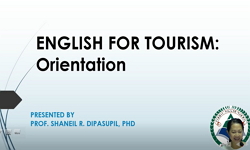This paper aims to analyse the preference for German farm tourism among the German population. For this reason, we conducted an empirical study in Germany during summer 2007 and we applieda structural equation model based on partial leasts quares(PLS)...
http://chineseinput.net/에서 pinyin(병음)방식으로 중국어를 변환할 수 있습니다.
변환된 중국어를 복사하여 사용하시면 됩니다.
- 中文 을 입력하시려면 zhongwen을 입력하시고 space를누르시면됩니다.
- 北京 을 입력하시려면 beijing을 입력하시고 space를 누르시면 됩니다.
https://www.riss.kr/link?id=A101190034
- 저자
- 발행기관
- 학술지명
- 권호사항
-
발행연도
2008
-
작성언어
English
-
주제어
PLS ; farm tourism ; agri ; tourism ; traveller ; preference
-
등재정보
KCI등재
-
자료형태
학술저널
- 발행기관 URL
-
수록면
33-59(27쪽)
- 제공처
-
0
상세조회 -
0
다운로드
부가정보
다국어 초록 (Multilingual Abstract)
This paper aims to analyse the preference for German farm tourism among the German population. For this reason, we conducted an empirical study in Germany during summer 2007 and we applieda structural equation model based on partial leasts quares(PLS) to analyse the data. In the following chapters we will introduce the literature review and our conceptual frame work. We will then outline the procedures we adopted and the results of the empirical analysis. In the final part so me conclusions will be presented and a discussion will follow in order to draw the future directions of our research. According to our hypotheses, the possibility that agri-tourism enters in the evoked set of an individual is higher: H1: The higher the information degree about it. H2: The lower the influence of the social stimuli. H3: The higher the physical exposure to it (experience). H4: The higher the wellness image of agri-tourism. H5: The higher the traditional image of agri-tourism. H6: The higher the exciting image of agri-tourism. H7: The higher the perceived value for money. Our further hypotheses affirm that the possibility that agri-tourism enters in the evoked set of an individual is higher: H8: The lower the perceived risk. H9: The higher the motive to enjoy a holiday in the nature. H10: The higher the motive to enjoy a sport holiday. H11: The lower the motive to have an organized holiday. H12: The lower the motive to have a holiday abroad. H13: The lower the motive of action and night life. H14: The higher the motive to spend a holiday with the family. H15: The lower the motive to spend a city holiday. Finally, our model has some socio-demographics data. As we mentioned before, German agri-tourism has traditionally been the travel destination of large-size families, with low-to-middle income. For that reason, our final hypothesises are the following: the possibility that agri-tourism enters in the evoked-set of an individual is higher: H16: The higher the number of family members. H17: The lower the family income. Since in this study we use a path model with a PLS approach, we are able to state some interrelations among the exogenous latent variables: H18: The motive of sport holiday has a positive influence towards nature motives. H19: The physical exposition to agri-tourism has a positive influence toward information. H20: The motive of family holiday has a negative influence toward the motive of action and night life. H21: Social stimuli have a positive influence towards individuals risk perceptions. H22: Social stimuli have negative influence towards experience. Data for this study were gathered via administrated questionnaires during the summer 2007 within the frame of an academic "marketing research" course. The corresponding t-values are assessed using the bootstrapping method with 500 re-samples. In our model 61% of the degree of appreciation of German agri-tourism (evoked set) is explained by five independent variables: value for money ($0.335^{{\ast}{\ast}{\ast}}$) (H7) experience ($0.267^{{\ast}{\ast}}$) (H3), exciting image ($0.204^{\ast}$) (H6) organisation ($-0.162^{\ast}$) (H11) and holiday abroad ($-0.156^{\ast}$) (H12). The variance explained ($R^2$) for the other endogenous variables are the following: nature 24.3%, information 14.1%, action holiday 13.8%, risk perception 5.8% and experience 2.4%. An overview can be inferred from table 5. The results also allow us to test each of the proposed hypotheses. With exception of organization and abroad, none of the others travel style factors (H9 to H15) seem to have any significant impact towards evoked set which leads to the rejection of the respective hypotheses. As expected, social stimuli have a significant influence on individuals' risk perception (H21 accepted), however neither the former nor the latter have a valuable impact on evoked set (rejection of H2 and H8). Besides, since the influence of social stim
동일학술지(권/호) 다른 논문
-
- 한국마케팅과학회
- 박종철(Park, Jong-Chul)
- 2008
- KCI등재
-
도서관의 이용패턴과 서비스품질이 정보화성과지각 및 만족에 미치는 영향
- 한국마케팅과학회
- 정형식(Jung, Hyung-Shik)
- 2008
- KCI등재
-
CRM구축과정에서 마케팅요인이 관계품질과 CRM성과에 미치는 영향
- 한국마케팅과학회
- 장형유(Jang, Hyeong-Yu)
- 2008
- KCI등재
-
Transfer of Marketing Knowledge within Multinational Corporations and Its Impact on Performance
- 한국마케팅과학회
- Lee, Byung Hee(李秉熙)
- 2008
- KCI등재





 ScienceON
ScienceON





